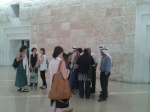First impressions from the West Bank
Half a day in the West Bank isn’t enough to get a the full picture of this complex and problematic region. This matter is to much entangeld and my knowledge about history and cultur of the West Bank is too poor as that I could write a full blog article about it. I hope that I have the chance to go back and to see more and speak to more people from both sides.
So far I leave you with a few general facts and the pictures I took, which already transfer a strong message I would say.
The West Bank has its origins in the Middle Ages, with the creation of the Kingdom of Jerusalem.
At the 1920 the area was allocated to the British Mandate of Palestine.
Following the Second World War, the United Nations passed the Nations General Assembly Resolution 181 (II) Future Government of Palestine, which aimed to establish two states within Mandate Palestine.
The Jewish leadership accepted the proposal but the Arab Higher Committee rejected it; a civil war began immediately, and Israel was declared in 1948.
Following the 1948 Arab-Israeli War this area was captured by Jordan.
In June 1967, the West Bank and East Jerusalem were captured by Israel as a result of the Six-Day War.
Since the 1993 Oslo Accords, parts of the West Bank are under full or partial control of the Palestinian Authority.
Settlements:
Shortly after independence, the Israeli Supreme Court ruled that the fundamental principles of international law, accepted as binding by all civilized nations, were to be incorporated in the domestic legal system of Israel.
Nevertheless, with government permission granted, Kfar Etzion was re-established in September 1967, becoming the first civilian settlement to be built in the West Bank. During the 1970s, Israel’s Supreme Court regularly ruled that the establishment of civilian settlements by military commanders was legal on the basis that they formed part of the territorial defense network and were considered temporary measures needed for military and security purposes
 The settlement Migron. Which was built in 1999 on Palestine land. The illegal outpost was ordered by the Supreme Court to be demolished last year but the settlers didn’t move until last week.
The settlement Migron. Which was built in 1999 on Palestine land. The illegal outpost was ordered by the Supreme Court to be demolished last year but the settlers didn’t move until last week.
The temporary houses build by the governement, where the settlers of Migron were moved to last week.
 A tennis court, zebra crossing, the settlement Biet El could be a small town in Germany. It is located in the hills north of Jerusalem and has currently a population of 5,308. According to the NGO Peace Now, private Palestinian property makes up 96.85% of the land that Beit El is built on.
A tennis court, zebra crossing, the settlement Biet El could be a small town in Germany. It is located in the hills north of Jerusalem and has currently a population of 5,308. According to the NGO Peace Now, private Palestinian property makes up 96.85% of the land that Beit El is built on.
 Parts of Beit El like these houses were evacuated late June. And the settlers were moved …
Parts of Beit El like these houses were evacuated late June. And the settlers were moved …
to this temporary houses built by the governement in the legal neighbourhoods of Beit El.
Hummus in Jerusalem- Eine Erzählung
Der Muezzin singt von den Höhen des Tempelberges in die Lautsprecher über den Dächern der alten Stadt.
Itamar, der der Hitze in Wanderschuhen trotzt, arbeitet an interviewsfälschenden Journalisten.
Gibt es nicht wichtigere Themen?, nörgelt die Deutsche Zitrone bevor ich sie ausdrücke und sie bis in das besetzte Ostjerusalem spritzt, aus dem abertausend Beseelte in die Al-Aqsa pilgern.
Die Frauen gleich schwarzem Stoff mit Glitzer, manche zeigen nur Augen und Nagellack, zwischen den gelebten Gesichtern unter der Kufiya halte ich Ausschau nach Arrafat, es wäre so ein interessantes Händeschütteln geworden.
So viele Fragen, dachten sich auch die Journalisten auf der Pressekonferenz, als sie falsche Interviews mit Hollywoodgrößen erfanden.
Ich dippe die Pita verständnisvoll in den kichernden Mus, der sitzt schwer, mein Magen spannt sich auf, wenn ich jetzt explodiere, wäre ich nicht die erste.
Doch ich will die Butze des würdigen Alten, der statt Gebeten Falafel frittiert, nicht ruinieren, ich mag seinen Sohn, der so ernsthaft dem Schnottern des halbstarken Hebräers mit amerikanischer Begleitung anhört.
Gleich Basketball und dann Pool erklärt dieser Blondgefärbtem, die gigglen in ihr Iphone.
Sie sind anders, da sie keinen Kreuzfahrtsticker tragen.
Die Sticker gibt es vor der Grabeskirche, sie prügeln sich um den Eingang zur Jesusgruft und küssen mit den Cappies die Steinplatten.
Ich wäre jetzt gern im kühlen Felsendom, Itamar will zurück an den Schreibtisch, er schnalzt die Zunge über Dreiviertel unberührtem Hummus, ich lenke mit Fragen über die Sperranlagen ab.
An deren Pforte klopft ein Hunzelmütterchen und hält sich ihr Palästinensertuch ans Auge, da man Sohn und Dorf zerstört hat.
So einfach ist das nicht, sagt Itamaer, dann sind wir schon verloren in weißgesteinten Gassen, kugeln Treppen hinunter und fallen in einen Pilgerstrom, der uns unter Drücken und Fluchen durch das Damaskustor hinausschwemmt.
Wir stranden in der Bushaltestelle, wo wir uns erschöpft das schweißnasse Haar ausschütteln.
Die Bilder dazu: pictured impressions










